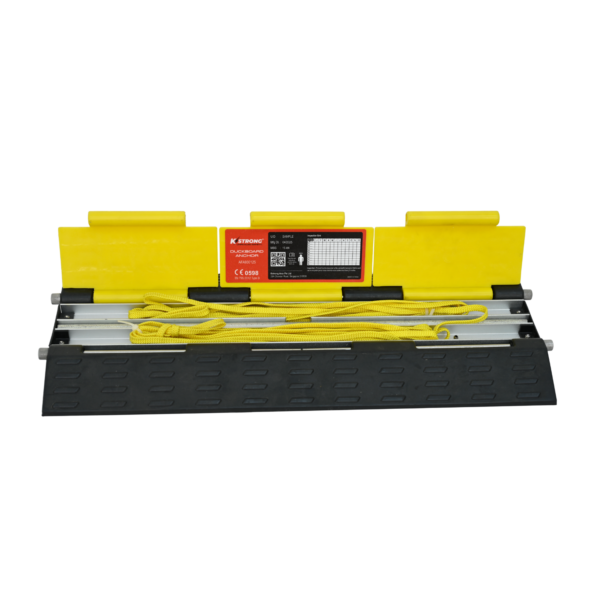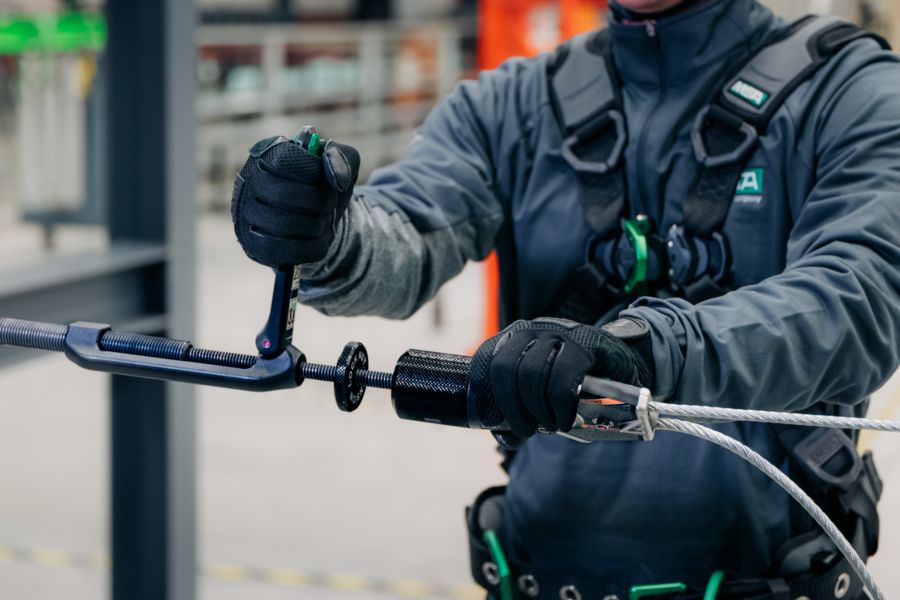
Understanding the Duckboard Anchor with Wire Loop
The Duckboard Anchor with Wire Loop plays a critical role in ensuring worker safety at heights. Designed for temporary or portable use, this specialized anchor provides a reliable connection point for personal fall arrest systems. Unlike fixed anchors, it can be easily installed on non-penetrating surfaces, making it an ideal solution for areas where drilling or structural modification is not allowed. This feature makes it a preferred choice among safety professionals in construction, maintenance, and energy industries. The duckboard base distributes weight evenly, preventing damage to delicate surfaces while maintaining firm stability. Its wire loop serves as a strong attachment point for lanyards or lifelines, ensuring secure connection during elevated work. With an emphasis on mobility, durability, and compliance, the Duckboard Anchor with Wire Loop has become an essential safety component across multiple industries that prioritize protection without compromising efficiency.
Structural Features and Design Advantages
The Duckboard Anchor with Wire Loop is engineered with precision to provide optimal performance in demanding environments. Its key components include a robust duckboard base that ensures surface stability and a corrosion-resistant wire loop designed for heavy-duty use. The materials used, typically stainless steel or galvanized metal, guarantee long-term reliability even in harsh outdoor conditions. This anchor is also lightweight, allowing workers to transport and position it effortlessly on-site. Another design advantage is its minimal surface impact, as it does not require permanent installation or drilling. This makes it ideal for temporary worksites or sensitive surfaces like coated roofs and platforms. The ergonomic build simplifies setup and dismantling, enhancing productivity while maintaining safety standards. When combined, these structural features ensure the Duckboard Anchor with Wire Loop delivers both protection and practicality for everyday operations.
How the Duckboard Anchor with Wire Loop Works
The functionality of the Duckboard Anchor with Wire Loop lies in its intelligent engineering that ensures maximum safety with minimal complexity. During installation, the anchor is placed on a flat, stable surface where the duckboard base provides non-slip support. The wire loop acts as a secure attachment point for a lifeline, lanyard, or other fall arrest equipment. Once connected, it distributes load forces evenly across the base, preventing any concentrated stress that could compromise structural integrity. Its design ensures that even in high-movement environments, the anchor remains firmly in place. Compatible with both temporary and permanent systems, it supports multiple working scenarios including roof access, platform maintenance, and confined space applications. The mechanism allows workers to focus on their tasks knowing that the anchor’s design mitigates the risk of falls effectively. This reliability makes it a preferred choice for teams prioritizing safety without sacrificing mobility.
Key Benefits of Using a Duckboard Anchor with Wire Loop
The Duckboard Anchor with Wire Loop offers multiple benefits that make it indispensable in professional safety systems. One of its primary advantages is enhanced worker safety through a stable, secure anchor point. It is designed for quick installation, which saves valuable time during setup while minimizing disruption to workflow. Because it’s reusable, it provides long-term cost savings compared to single-use anchoring options. The anchor’s flexibility allows it to be used in various settings, including metal roofs, elevated walkways, and maintenance platforms. Furthermore, its non-penetrating nature preserves the integrity of the surfaces it rests on.
Other major benefits include:
- Compliance with OSHA and ANSI standards for fall protection equipment
- Reduced setup and dismantle time for temporary worksites
- Corrosion-resistant materials ideal for outdoor and industrial use
- Easy transport and storage due to its compact, lightweight build
- Versatility for different job applications and surfaces
This combination of features ensures the Duckboard Anchor with Wire Loop provides unmatched protection, convenience, and reliability for workers exposed to fall hazards.
Comparing Duckboard Anchors with Other Anchor Types
Duckboard anchors stand apart from other anchor types because of their design and intended application. Traditional fixed-point anchors require drilling or permanent installation, which is not always possible or desirable. Beam anchors, while strong, are limited to specific structures like I-beams, and concrete anchors are often labor-intensive to install. In contrast, the Duckboard Anchor with Wire Loop offers immediate usability without altering the surface. It’s especially useful for projects that demand frequent relocation or short-term anchoring solutions.
Key comparisons include:
- Setup time: Duckboard anchors install faster than most permanent anchors.
- Portability: Unlike heavy fixed anchors, they can be carried easily between job sites.
- Surface protection: The duckboard base prevents scratching or damage to finished surfaces.
- Versatility: They adapt to a wider range of surfaces than beam or concrete anchors.
- Maintenance: Easier to inspect and maintain over time.
Safety managers often prefer the Duckboard Anchor with Wire Loop when mobility and adaptability are priorities, particularly on temporary worksites or during maintenance tasks.
Maintenance and Inspection Best Practices
To ensure maximum safety, regular inspection and maintenance of the Duckboard Anchor with Wire Loop are crucial. Every use should begin with a visual inspection for wear, rust, or deformation on the wire loop and base. Periodic deep cleaning using mild detergent and water helps remove dirt and debris that may compromise grip or metal longevity. It’s also important to dry the anchor thoroughly before storage to prevent corrosion. Documentation plays a vital role as well—keeping records of inspection dates, findings, and maintenance actions supports compliance with safety regulations.
When not in use, the anchor should be stored in a dry environment away from direct sunlight or chemicals that could degrade the material. During field inspections, any damaged or worn components must be replaced immediately. Workers should receive regular training on identifying warning signs that indicate the anchor is unsafe for use. By following these maintenance steps, teams can extend the lifespan of the Duckboard Anchor with Wire Loop and maintain consistent protection standards.
Choosing the Right Duckboard Anchor with Wire Loop for Your Job
Selecting the right Duckboard Anchor with Wire Loop depends on the specific requirements of each job. Factors such as surface type, load capacity, exposure to elements, and the number of workers connected to the anchor must be carefully assessed. For industrial sites, heavy-duty stainless steel models may be more appropriate due to their superior corrosion resistance. In contrast, lighter materials may suit indoor maintenance or inspection work.
Key considerations when choosing the right anchor include:
- Compatibility with your fall arrest or restraint system
- Verified load rating that meets or exceeds OSHA standards
- Surface type (metal, composite, or concrete)
- Environmental exposure such as moisture or chemical contact
- Manufacturer certifications and testing results
Consulting a safety equipment specialist ensures that the selected anchor fits your operational and regulatory requirements. A properly chosen Duckboard Anchor with Wire Loop not only safeguards workers but also ensures compliance with safety laws and reduces liability risks.
Safety Standards and Certification Requirements
The Duckboard Anchor with Wire Loop must comply with established industry standards to ensure optimal performance. OSHA and ANSI define strict regulations governing temporary and permanent anchorage systems for fall protection. Each product must undergo rigorous testing to verify its load-bearing capacity and resistance to environmental stressors. Manufacturers typically include documentation outlining the anchor’s compliance and testing results, which safety officers should review before deployment.
Proper certification also ensures that the anchor is traceable, with serial numbers or markings that identify manufacturing details. During safety audits, documented certification serves as proof of compliance, minimizing regulatory risks. Companies that prioritize certified equipment benefit from reduced workplace incidents and a higher standard of employee safety. Understanding these requirements helps project managers and safety officers make informed purchasing and operational decisions.
Real-World Applications and Scenarios
The Duckboard Anchor with Wire Loop is versatile enough to serve multiple real-world applications. It’s commonly used on rooftops during maintenance work, where workers require secure fall protection without drilling into the surface. Industrial plants utilize it for elevated platform access, while refineries rely on it during inspections and cleaning operations. Its lightweight design and easy setup make it ideal for contractors who frequently move between job sites.
In marine environments, where corrosion resistance is essential, the anchor’s stainless-steel components provide added reliability. Likewise, in construction, it offers stability for workers handling roofing, HVAC installation, or painting tasks at heights. The anchor’s adaptability makes it a vital part of modern fall protection systems, ensuring both safety and efficiency regardless of the working environment.
Common Mistakes to Avoid When Using Duckboard Anchors
While the Duckboard Anchor with Wire Loop is designed for safety, improper use can still pose risks. Common mistakes include placing it on unstable or uneven surfaces, which may cause slippage. Overloading the anchor beyond its rated capacity can lead to equipment failure. Another frequent oversight is neglecting to inspect the anchor before each use, which may result in undetected wear or damage. Workers must also ensure compatibility between the anchor, lanyard, and harness to maintain system integrity.
Avoid these common errors:
- Failing to read manufacturer instructions
- Ignoring surface stability before placement
- Using non-certified accessories or connectors
- Reusing the anchor after a fall event without inspection
- Skipping periodic maintenance
By addressing these mistakes, worksites can maintain a consistent standard of safety and minimize potential hazards during operations.
Future Innovations in Portable Anchor Systems
The future of fall protection technology continues to evolve, and the Duckboard Anchor with Wire Loop remains part of this advancement. New materials such as high-strength alloys and composite fibers are making anchors lighter yet stronger. Smart monitoring systems are being developed to track anchor use and detect overloading or improper installation through IoT integration. Manufacturers are also focusing on sustainability, using eco-friendly materials that reduce environmental impact.
As workplaces continue to demand flexibility, the next generation of duckboard anchors will likely feature enhanced adjustability and modular designs. These innovations aim to improve both performance and user convenience while maintaining strict safety standards. This ongoing evolution ensures that fall protection equipment remains reliable, efficient, and adaptable to the changing needs of modern worksites.
Frequently Asked Questions (FAQ)
1. What is the maximum load capacity of a Duckboard Anchor with Wire Loop?
Most models are rated between 5,000 to 10,000 pounds, depending on manufacturer specifications.
2. Can it be used on all roof types?
Yes, as long as the surface is stable and compatible with the anchor’s base design.
3. How do I know if the anchor is properly secured?
Ensure the duckboard base lies flat and that the wire loop is tightly fastened before use.
4. Is it reusable after a fall event?
It should be thoroughly inspected by a qualified safety professional before reuse.
5. What certifications should I check for?
Look for OSHA and ANSI compliance markings on the product and accompanying documentation.
6. How should it be cleaned and stored?
Clean with mild detergent and water, then store in a dry, shaded environment.
7. Are replacement wire loops available?
Yes, many manufacturers offer replaceable components to extend product lifespan.
8. How long does it last with proper care?
Typically several years, depending on frequency of use and maintenance quality.
Takeaway
The Duckboard Anchor with Wire Loop is an essential safety device that enhances protection for workers operating at heights. Its non-penetrating design, easy setup, and compatibility with various surfaces make it a versatile solution for modern worksites. By combining robust engineering with compliance to safety standards, it ensures reliability, portability, and efficiency. Regular maintenance, proper training, and adherence to manufacturer guidelines further strengthen its performance. Investing in a Duckboard Anchor with Wire Loop means investing in the safety, productivity, and peace of mind of every worker who relies on secure fall protection daily.


